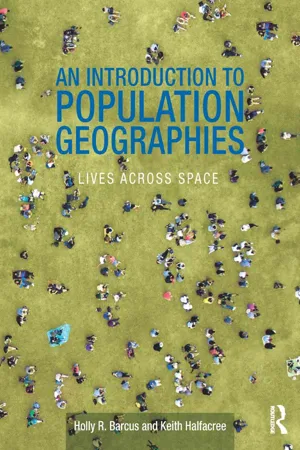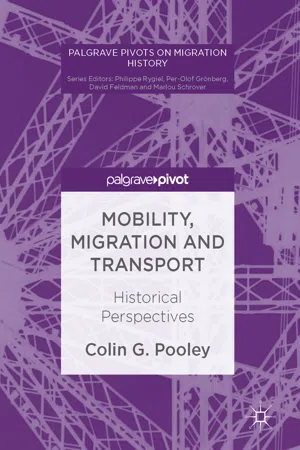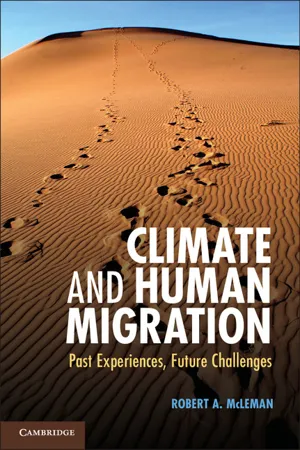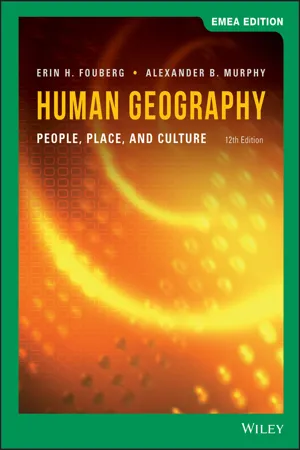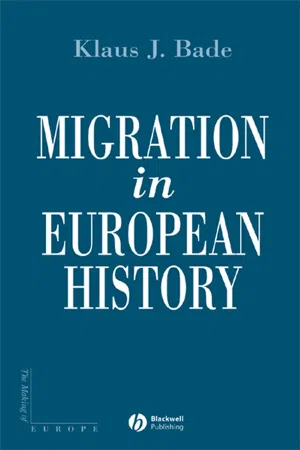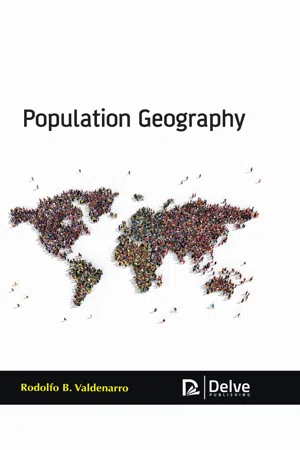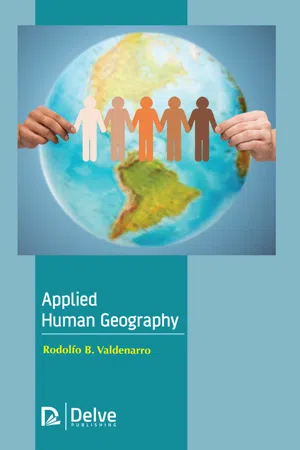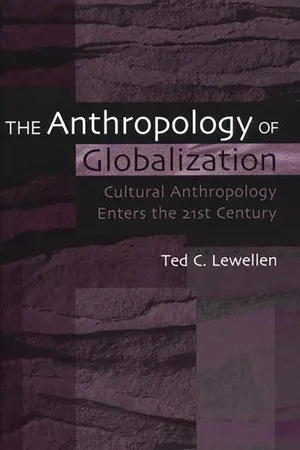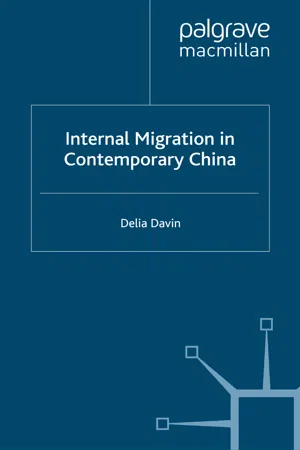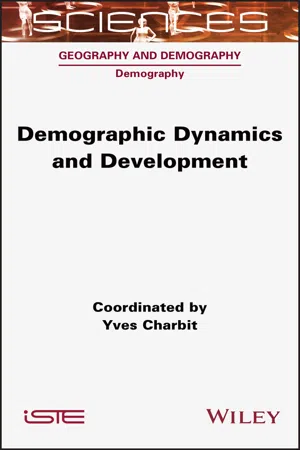History
Migration
Migration refers to the movement of people from one place to another, often in search of better living conditions, opportunities, or to escape hardship. Throughout history, migration has been a significant factor in shaping societies, cultures, and economies. It has led to the exchange of ideas, technologies, and traditions, contributing to the diversity and interconnectedness of the world.
Written by Perlego with AI-assistance
Related key terms
1 of 5
11 Key excerpts on "Migration"
- eBook - ePub
An Introduction to Population Geographies
Lives Across Space
- Holly R. Barcus, Keith Halfacree(Authors)
- 2017(Publication Date)
- Routledge(Publisher)
CHAPTER 5Placing human Migration5.1 INTRODUCTION: DEFINING Migration
5.1.1 What is Migration?
Migration remains the most widely studied and examined element within Population Geography (Boyle 2003, 2004). Moreover, whilst Geographers have played a pivotal role in shaping our contemporary understanding of it, the topic is of interest to numerous academic disciplines, including Demography, Sociology, Political Science, Economics and Anthropology (Brettell and Hollifield 2008a). In this respect, approaching Migration as it occurs within the life course has considerable potential for bringing together a scattered body of scholarship often fragmented by “disciplinary partitioning” (Olwig and Sørensen 2002: 7).But what exactly is Migration? Initially put, as in a recent textbook, it is “the movement of people to live in a different place” (Holdsworth et al. 2013: 96) or a “permanent change in residence.” It is residential relocation. Or, as expressed in UK and US censuses, a Migration is deemed to have occurred when one’s “usual address” has changed within the last 1 or 5 years, respectively (ONS 2013; USCB 2013). Simple, then, one might think! However, as Holdsworth et al. (2013: 98) also noted, careful consideration of these definitions immediately raises a host of questions: what precisely is meant by “different place,” “live in,” “permanent,” or “usual address”? Consequently, by the end of the present chapter, “Migration” will have been demonstrated to be at least as complex and multi-dimensional a concept as Chapter 4 revealed “fertility” to be.Starting with the idea of “different place,” the type of areal unit(s) involved in a Migration is an initial important consideration when defining it specifically. A crucial starting point is whether a political boundary is crossed during a move. For example, an individual could move from one county to another within the same US state or from one state to another. Both moves are conventionally described as intra-national or internal Migration, because neither involves leaving the US. In contrast, a move from the US to Canada, crossing an international border, is an international Migration - eBook - PDF
Mobility, Migration and Transport
Historical Perspectives
- Colin G. Pooley(Author)
- 2017(Publication Date)
- Palgrave Macmillan(Publisher)
In such movements it can be suggested that we see the development of transnationalism – the retention of ties to more than one country following Migration – long before it became fully recognised as a common twenty-first century characteristic of global Migration (Vertovec 2009; Van Hear 2014). Sometimes Migration historians attempt to differentiate between voluntary and involuntary migra- tion, but for most migrants this distinction is blurred. Truly involuntary Migration AND MOBILITY THROUGH THE LENS OF HISTORY 23 movements were those undertaken under conditions of custody or slavery, as was the case for those transported as convicts from Britain to the Americas and Australia and, most significantly, those Africans shipped from West Africa under the harshest conditions to be sold as slaves in America and the Caribbean (Thomas 1997; Kercher 2003; Klein 2010). All other Migration decisions occur as a result of a combination of pull and push factors; though in many cases – for instance refugees fleeing war or persecution – the migrants may reasonably feel that they have no option but to move (Black and Robinson 1993). It can also be argued that where a Migration decision is taken by the (usually male) household head family dependents (especially young children) are forced to move. Migration history is diverse and covers a wide range of topics, but for the most part research has been concerned with five major areas of interest. First, some research focuses on the demographic impacts of Migration, concentrating on the ways in which population movement alters the size and, especially, composition of regions and nations. Second, and related to this, research also examines the social and eco- nomic impacts of out-Migration on areas of origin, especially with regard to rural population loss and the economic effects of out-Migration by those with particular skills. - eBook - PDF
Climate and Human Migration
Past Experiences, Future Challenges
- Robert A. McLeman(Author)
- 2013(Publication Date)
- Cambridge University Press(Publisher)
For migrants travelling long distances to settle in new and unfamiliar places, Migration may be a long and arduous process, with integration into the destination population never completed within the migrant’s own lifetime, but continued by subsequent generations. The Migration process as experienced by the individual does not exist in a vacuum; it is nested within larger sets of dynamic and interconnected cultural, economic, envi- ronmental, political, and social processes that shape human behavior more gener- ally. A decision to migrate today may be the product of any number of antecedent 2 Why People Migrate 2.2 Basic Assumptions of Modern Migration Research and Their Origins 17 conditions and events. And, once acted upon, the decision to migrate generates new sets of risks and opportunities not only for the migrant, but for his or her social net- work, and for the sending and receiving communities as well. Migration is more than simply a movement across physical space; it is a change in the trajectory of an indi- vidual and those connected to that individual through social space. The aim of this chapter is to provide the nonspecialist a clear overview of current scholarly understanding of the Migration process and to introduce a set of basic the- ories, concepts, and terms that: Have been used in a wide variety of settings to explain and interpret how Migration deci- • sions are made and the factors that shape Migration behavior generally; Can be used to describe and analyze in a systematic fashion known examples of Migration • related to droughts, floods, extreme weather events, and other climate-related phenomena; and Will be combined in • Chapter 3 with scholarship that considers human vulnerability and adaptation to climatic variability and change in order to create a conceptual framework that shows the interactions between climate and Migration within the context of an adaptive human-environment system. - eBook - PDF
Human Geography
People, Place, and Culture
- Erin H. Fouberg, Alexander B. Murphy(Authors)
- 2020(Publication Date)
- Wiley(Publisher)
Most are migrants who reported average salaries of less than $150 a month. This chapter explores why people migrate, whether by force or voluntarily. We discuss where people migrate, both within countries and across country borders, and how governments impact Migration. CHAPTER OUTLINE 3.1 Explain Migration as a type of movement. • Cyclic Movement • Migration 3.2 Explain Historic and Modern Forced Migration. • Historic Forced Migration • Modern Slavery and Human Trafficking 3.3 Explain the Theories of Migration and Understand the Motivations for Migration. • Laws of Migration and the Gravity Model • Push and Pull Factors 3.4 Identify why refugees are a distinct group of migrants and describe where most refugees migrate. • Distribution of Refugees • Areas of Dislocation 3.5 Determine how government policies impact Migration. • Waves of ImMigration in the United States • Legal Restrictions Photo by A.B. Murphy. © 2020 John Wiley & Sons, Inc. FIGURE 3.1 Mumbai, India. A view from the top of a high-rise in the central city, looking at one of the slums found tucked between buildings throughout the city. The Census of India reports that more than 50 percent of the Mumbai’s residents live in slums. 3.1 Explain Migration as a Type of Movement 63 Migration is a type of movement that changes both the places migrants leave and the places they go. The movement of peo- ple along paths of Migration creates connections and networks among places. Migration changes how people see themselves and others. It also increases spatial interaction and speeds the diffusion of ideas and innovations among places connected through Migration. Geographers identify two basic types of movement. Leav- ing home for a defined amount of time and returning home is called cyclic movement. Migration changes the location of home and has a degree of permanence not found in cyclic movement. Migration is movement from a home location to a new place with an intent to stay in the new place permanently. - eBook - PDF
- Klaus Bade, Allison Brown(Authors)
- 2008(Publication Date)
- Wiley-Blackwell(Publisher)
In geographical terms, despite considerable overlap it is possible to distinguish among, for example, eMigration, imMigration and internal Migrations. It is also helpful to ask what were the causes, motivations and aims of these Migrations. Economic and socio-occupational consid- erations, for example, can be further narrowed down, distinguishing between employment Migrations as subsistence Migration or betterment Migration, and career Migrations for the purpose of attaining further qualifications or training, or Migration within branches of one company. Survival Migrations, involving people for whom the late twentieth cen- tury coined the collective term ‘environmental refugees’, also took place owing to loss or destruction of economic means of subsistence and were thus ultimately also motivated by economic factors. Migrations for such reasons can in turn be viewed as separate from refugee or forced migra- tions on religious, ideological, political, ethnonationalist or racism- related grounds. These include the expulsions and forced resettlements of the twentieth century in which movements of people over borders were often the result of borders shifting over people. Migratory patterns can also be sought, again bearing in mind the numerous transitions and intermediary forms, by distinguishing between local and circular, and between temporary (e.g., Migration for work or training) and permanent (e.g., eMigration and imMigration). Transitions from temporary to permanent forms were usually marked by chain Migrations. Migration traditions that developed through the migratory events themselves, together with the transfer of information between places of origin and destination via Migration networks, accompanied and at the same time stabilized circular Migration systems and eMigration and imMigration movements. - eBook - PDF
- Rodolfo B. Valdenarro(Author)
- 2020(Publication Date)
- Delve Publishing(Publisher)
HUMAN Migration 4 CONTENTS 4.1. Introduction ...................................................................................... 88 4.2. Why People Migrate? ........................................................................ 88 4.3. Types of Human Migration ................................................................ 95 4.4. Type of The Human Who Migrate .................................................... 105 Population Geography 88 4.1. INTRODUCTION Migration is the movement of people from one location to another with the goals of staying, forever or interim at a fresh place. The movement is frequently over long intervals and from one location to another, but domestic Migration is also feasible; actually, this is the superior form worldwide. People may move as individuals, in household units or groups of large people. A person who migrates from their residence due to natural catastrophes or civil rivalry may be construed as an alien or refugee or, chiefly within the same nation, as an internally displaced people. A person looking for refuge from religious, political or other ways of discrimination is usually construed as a shelter seeker. The difference betwixt spontaneous (running political rivalry or natural calamities) and non-spontaneous Migration (commercial or Migration of labor) are hard to make and partly idiosyncratic, as the instigators for Migration are often comparable. The World Bank approximated that, as of the year 2010, around 16.3 million migrants certified as refugees. This number rose to 19.5 million by the year 2014. At levels of approximately 3%, the percentage of migrants among the population in the world has continued unusually constant over the past five decenniums. Movements among the nomads are mostly not viewed as Migrations as the Migrations are always intermittent; there is no objective to reside in the new locality. - eBook - PDF
- Rodolfo B. Valdenarro(Author)
- 2019(Publication Date)
- Delve Publishing(Publisher)
In the meantime, a few people will move into the UK. Outsiders add to the complete populace and exiled people are subtracted from the aggregate. In some cases, individuals simply move starting with one area then onto the next inside a similar nation. In many creating nations, huge quantities of individuals have moved from the field to the urban areas as of late. This is called rustic to urban relocation. Now and then individuals have a decision about whether they move, yet once in a while they are compelled to move. The reasons individuals leave a spot are known as the push factors. The reasons individuals are pulled in to new places to live are known as the draw factors. Broad human relocation has a long history. Our species, Homo sapiens, developed in East Africa around 200,000 years back. The most punctual current human fossils found outside of Africa are around 100,000 years of age. The relatives of these first pioneers kept on spreading through the world, reaching Australia by 60,000 to 50,000 years back, the Europe by 40,000 years prior, and the America by 20,000 to 15,000 years back. The last real landmass to be populated was New Zealand, which was come to toward the finish of the Polynesian relocations in around 1280 CE. Figure 9.1: Representation of Migration. Source: http://www.picpedia.org/highway-signs/images/Migration.jpg Applied Human Geography 186 Relocation is a worldwide marvel; no area and couple of nations are unaffected by it. In 2013, the quantity of global vagrants moving between creating nations or between high-pay nations was equivalent to South–North developments. Most nations today are nations of birthplace, travel and goal for global relocation. Movement has since quite a while ago added to monetary advancement and social prosperity in both goal and root nations. It has existed since days of yore, regardless of whether its character and the quantities of vagrants fluctuate with time and conditions. - eBook - PDF
The Anthropology of Globalization
Cultural Anthropology Enters the 21st Century
- Ted C. Lewellen(Author)
- 2002(Publication Date)
- Praeger(Publisher)
During anthropology's classic period, through the 1960s, the dominant models of Migration were largely based on push and pull factors that either drove rural peoples out of the countryside or attracted them to cit- ies. Once in the city or in another country, migrants would assimilate into the dominant culture, perhaps over a generation or two. The modern period is characterized by neo-Marxist models that focus on structural inequalities that siphon people from less developed to more developed regions in search of jobs. The recent period may be characterized as still emergent: Models focus less on general theories and more on the specifics of particular migra- tions. Migration is viewed as extremely complex, as are the motives and experiences of those who move. In contrast to "assimilation" and 132 Globalization and Migration "cost-benefit," the new vocabulary of Migration is one of transnationalism, diaspora, multiculturalism, citizenship acquisition, social movements, and refugees (Heisler 1992). Since the earliest studies, anthropological approaches to Migration have been closely tied to economic development theory, because, almost invari- ably, movement was from a less to a more developed region. Because urban areas are the focal points of development, much of internal Migration theory was tied to the rural base at one end and the city at the other. Anthropologi- cal research on international Migration tended to follow the same underde- veloped-to-developed trajectory, but not necessarily with the urban focus, as in the much-studied Mexican Migration of agricultural workers to the United States. 6 Migration and Modernization Theory As interpreted by Michael Kearney (1986), Migration theory in anthro- pology has accompanied development theory through three key phases: modernization, dependency, and articulation. - eBook - PDF
- D. Davin(Author)
- 1998(Publication Date)
- Palgrave Macmillan(Publisher)
4 Why People Migrate The very first year we farmed our contract land the crops failed. The grain we got was next to nothing - never mind paying our taxes, it wasn't even enough to keep belly from backbone. That's why there's so many of us trying to make a living in the city this year. Some of the men pop corn and some of them are in construc- tion teams putting up buildings for the government. The women have gone to the cities as maids. None of us arc beggars, at least none from our village .... We leave the village to work and make money .... We started working when we got to Hefei. We worked there for a week and then made enough for our fares to Beijing. Making money in the big cities is easy. (Child migrant from Anhui interviewed in Beijing in 1984. Zhang and Sang 1986: 3-7) Individuals migrate because they think that they can improve their own lives or those of their families by doing so. Economic Migration is triggered by the knowledge (or belief) that better economic opportu- nities exist in some other place. It follows that where regional and local economic inequality is considerable, people are like ly to migrate if it is possible for them to do so. Factors such as poverty, lack of econ- omic opportunity, land shortage and low living standards at home function as push factors, while prosperity, opportunity, available employment and higher living standards in the place of destination are pull factors. The individual's decision to migrate involves a process of weighing up potential costs and benefits. 1 Migrants have to consid er general factors such as the cost of travel and accommodation, the chances of finding work and the prevailing wage rates in the destina- tion area compared with those in the home area. They will also be swayed by individual factors such as contacts with relatives or friends in the destination areas, or the potential effect of their absence on the household left behind. - eBook - PDF
Global Migrants, Local Culture
Natives and Newcomers in Provincial England, 1841-1939
- Laura Tabili(Author)
- 2011(Publication Date)
- Palgrave Macmillan(Publisher)
22 Colonial subjects formed but part of a continually shifting population that yielded a diverse and dynamic society and culture. Analysing migra- tion to, from and through South Shields reinforces understanding of cultures as processual, continually reconfigured through agency and practice and through interpenetrations between the local and global, national and regional. 23 Migrants and natives alike took part in indus- trial expansion, empire building and war, global processes sprawling across boundaries and borders, seas and oceans. Understanding how diverse populations came together to interact, coexist or conflict can help re-envision cultures themselves as products of ongoing historical change. Migration in European and global context The history of South Shields, its people and culture remains insepa- rable from those of global economic transformation, class experience and class struggle, and the massive movement of population char- acterizing the past two centuries. This enquiry thus rests on a sub- stantial and distinguished scholarship on British, European and global Migration. 24 Scholars have repainted our picture of pre-industrial Europe to stress population mobility and fluidity, undermining views of rural life as timeless and unchanging, or premodern people as sedentary and isolated. Hardly an unprecedented and disruptive effect of industrial- ization, the circulation of people, artifacts and practices began with human history. 25 A ubiquitous cultural practice among rural as well as urban populations, Migration affected those who stayed as well as those who moved. Individual, short-distance and quotidian ‘mun- dane movements’ predominated, often seasonal or circular, among villages, towns and regional centres. 26 Still, internal Migration and eMigration overseas proved complementary, exhibiting fundamental continuities between shorter and longer distance, temporary and perma- nent Migrations, pre-industrial and industrial-era patterns. - eBook - PDF
- Yves Charbit(Author)
- 2022(Publication Date)
- Wiley-ISTE(Publisher)
The issues of rural decline, urbanization/industrialization and transoceanic Migration made for a complex series of changes, but we must keep in mind that they overlay existing patterns of mobility. Local Migration systems maintained a certain importance as other kinds of mobility grew. Teams of harvest workers and construction workers that moved seasonally built the cities and supplied them with food. Simultaneously, chain Migration systems expanded as more people sought urban work where their kin and compatriots had gone before. Finally, career Migration expanded as the growth of postal and educational systems, the bureaucratization of government functions and the creation of the nation states of Germany and Italy meant that unprecedented numbers of officials, clerks and school teachers were assigned to posts by the state. And every kind of Migration system included more women than before. Dynamics of Migration History in Western Europe 159 7.4.1. The character of the age International conflicts, state restrictions and laissez-faire policies all influenced Migration in the period between 1815–1914. It was preceded by a decade of revolution in France that stretched into 25 years of conflict. France’s civil wars, international wars and divisions sent some 200,000 French people out of the country as émigrés, largely in 1793–1794. The revolutionary decade took a toll on France’s cities, whose population declined as the demand declined for luxury goods, servants and construction workers; for example, Paris lost 12% of its population between 1790 and 1806. France’s general call-up (levée en masse) in 1793 ushered in a period of mass armies across the continent that would take young men – the most likely of migrants – out of the labor force and into battle from Moscow to Spain.
Index pages curate the most relevant extracts from our library of academic textbooks. They’ve been created using an in-house natural language model (NLM), each adding context and meaning to key research topics.
